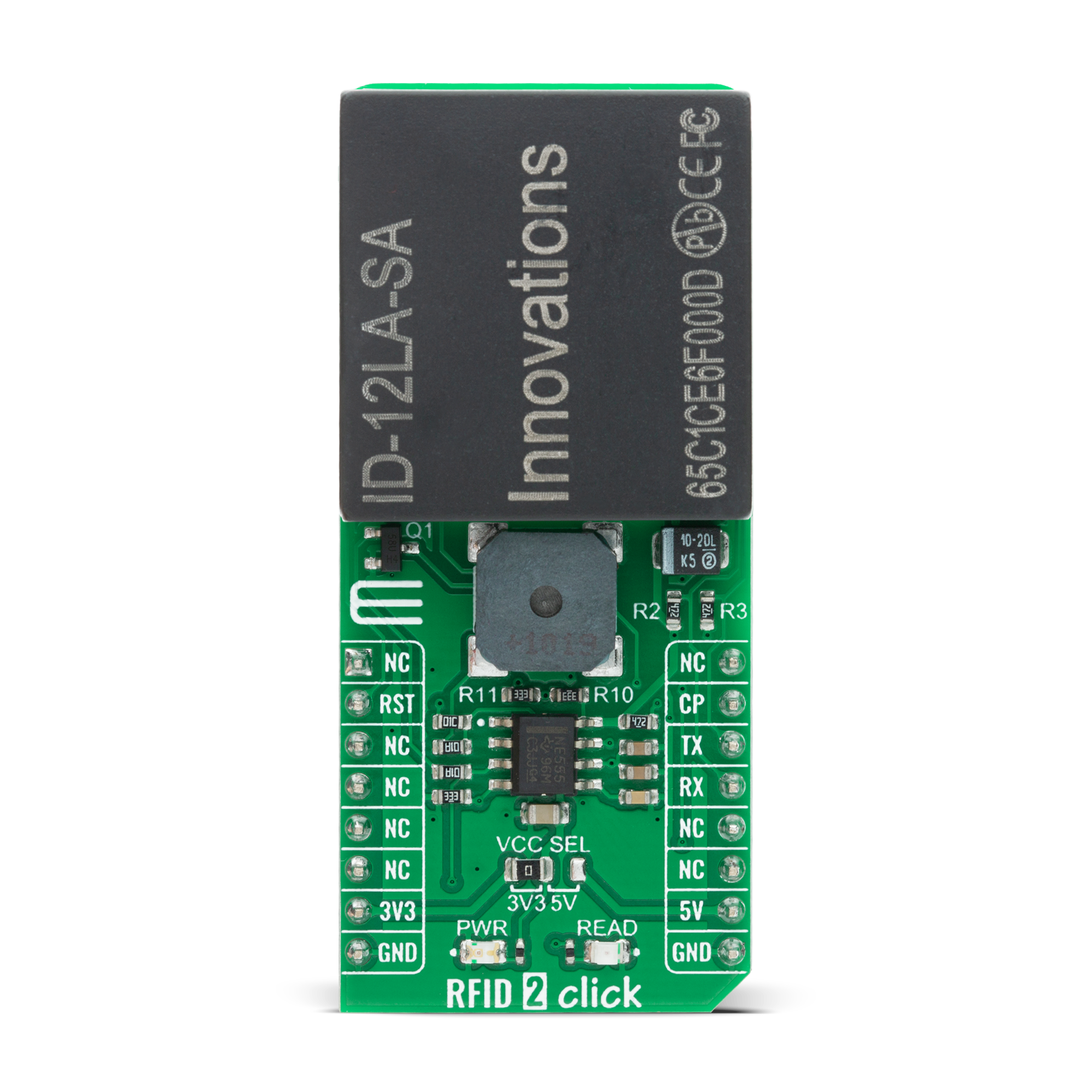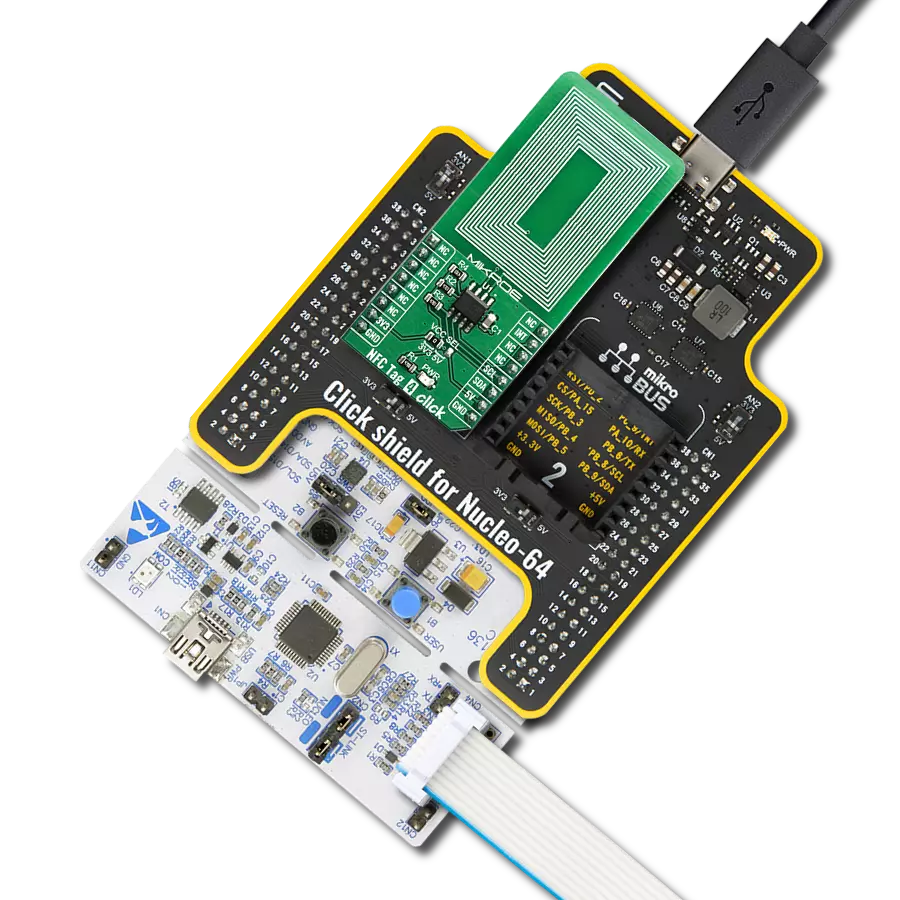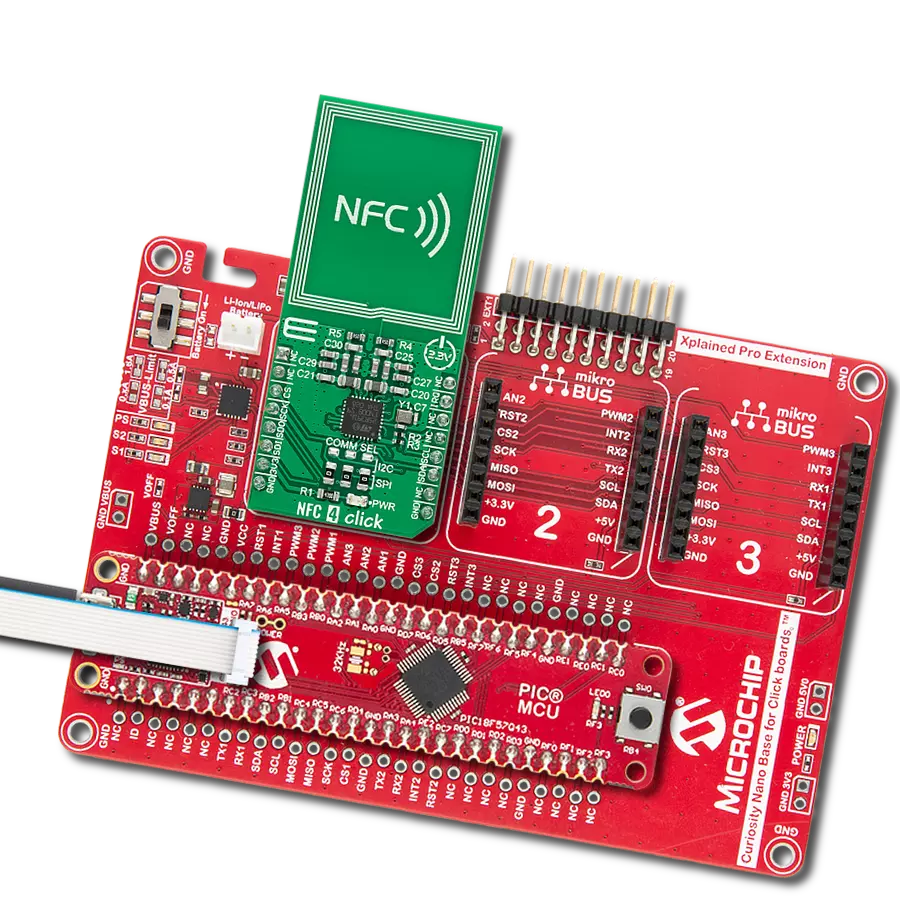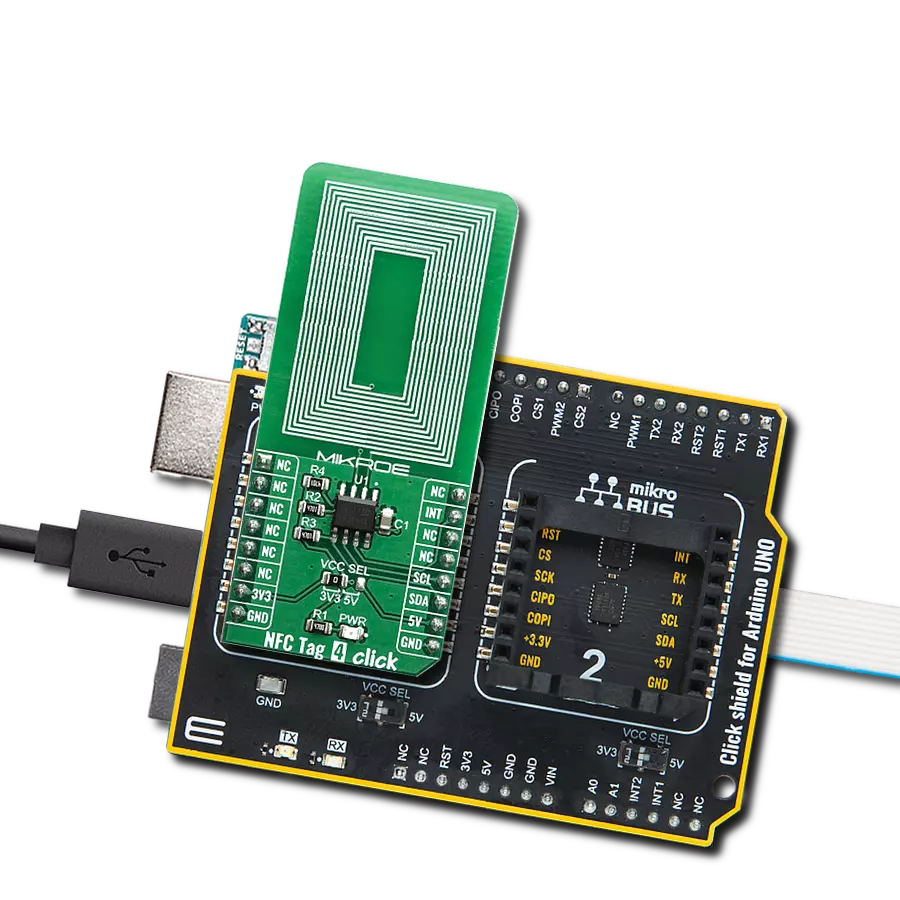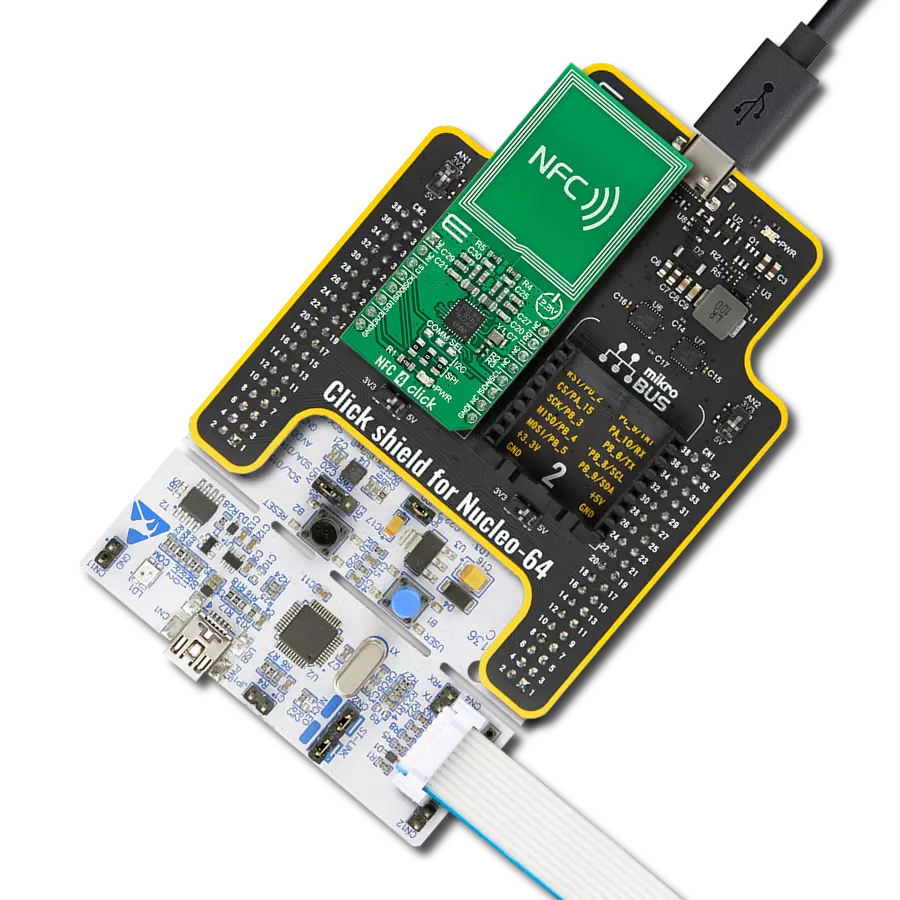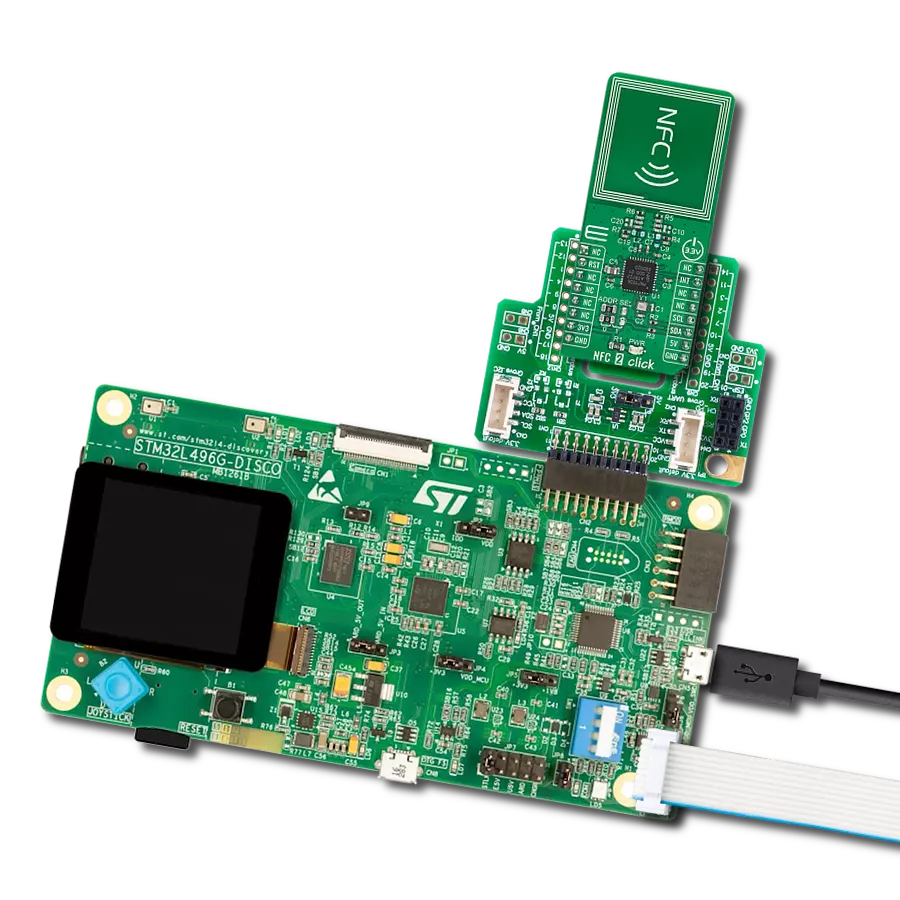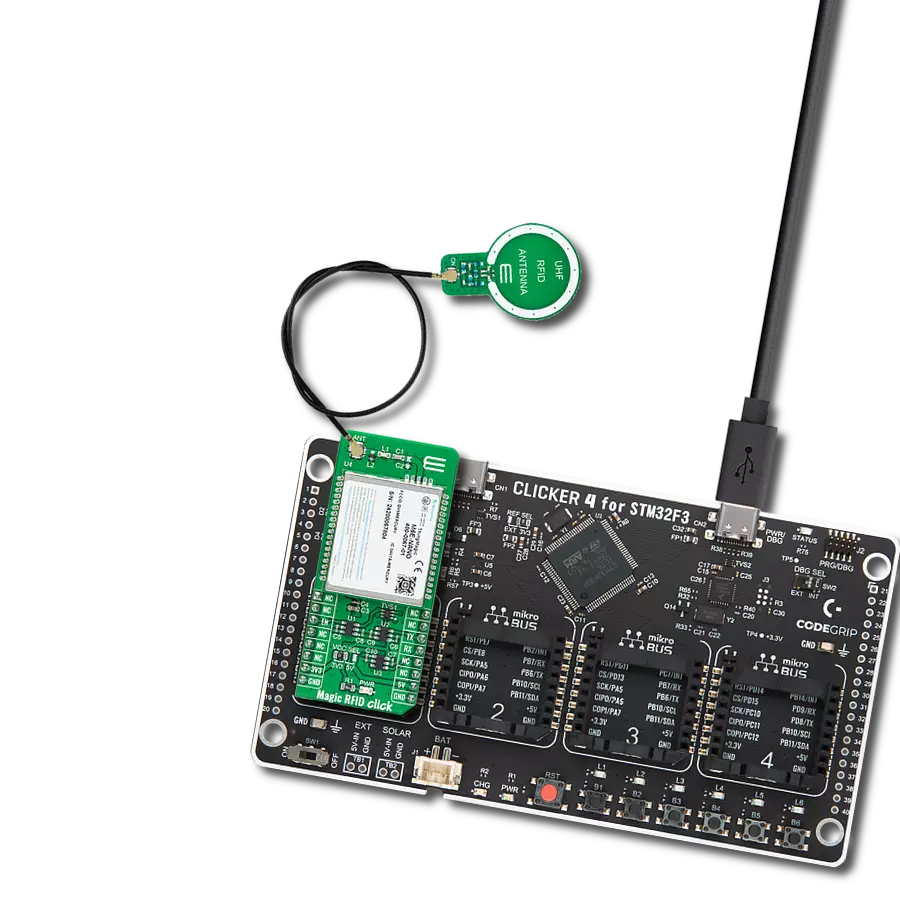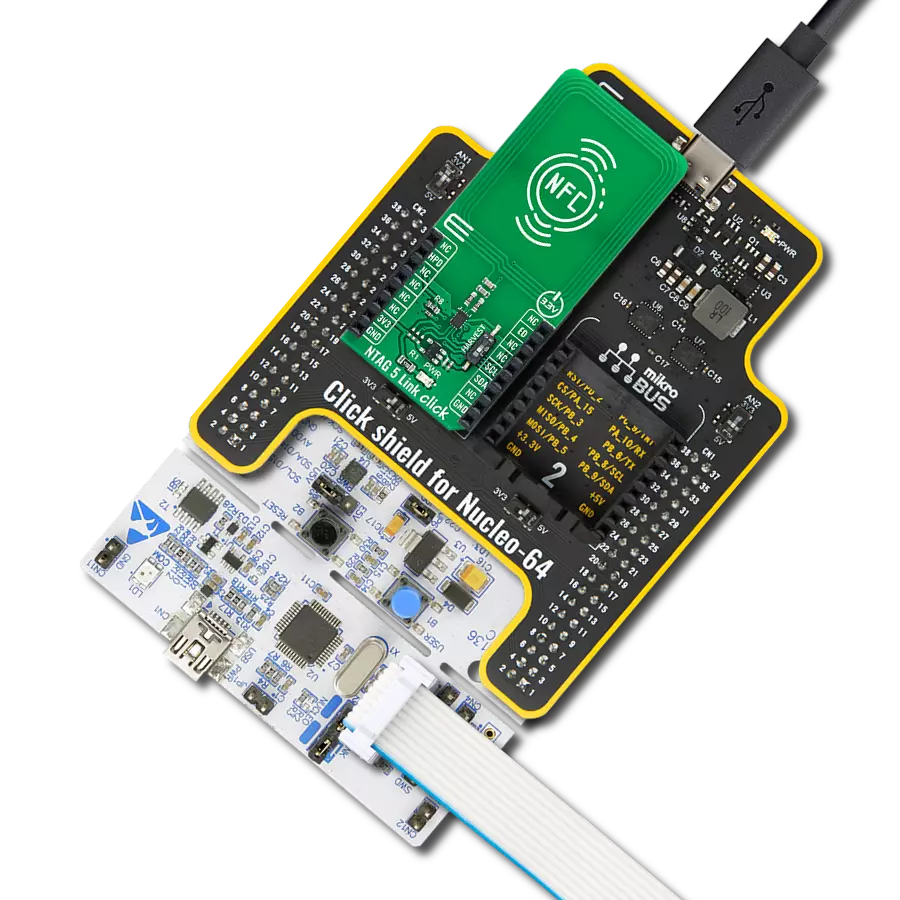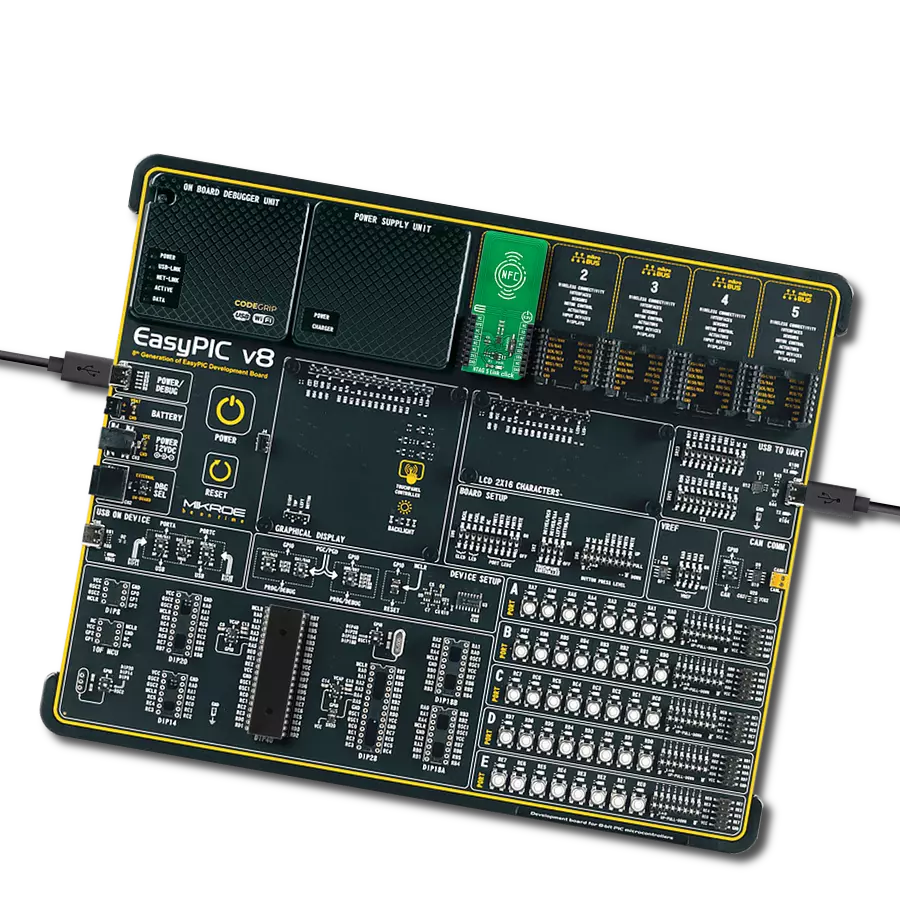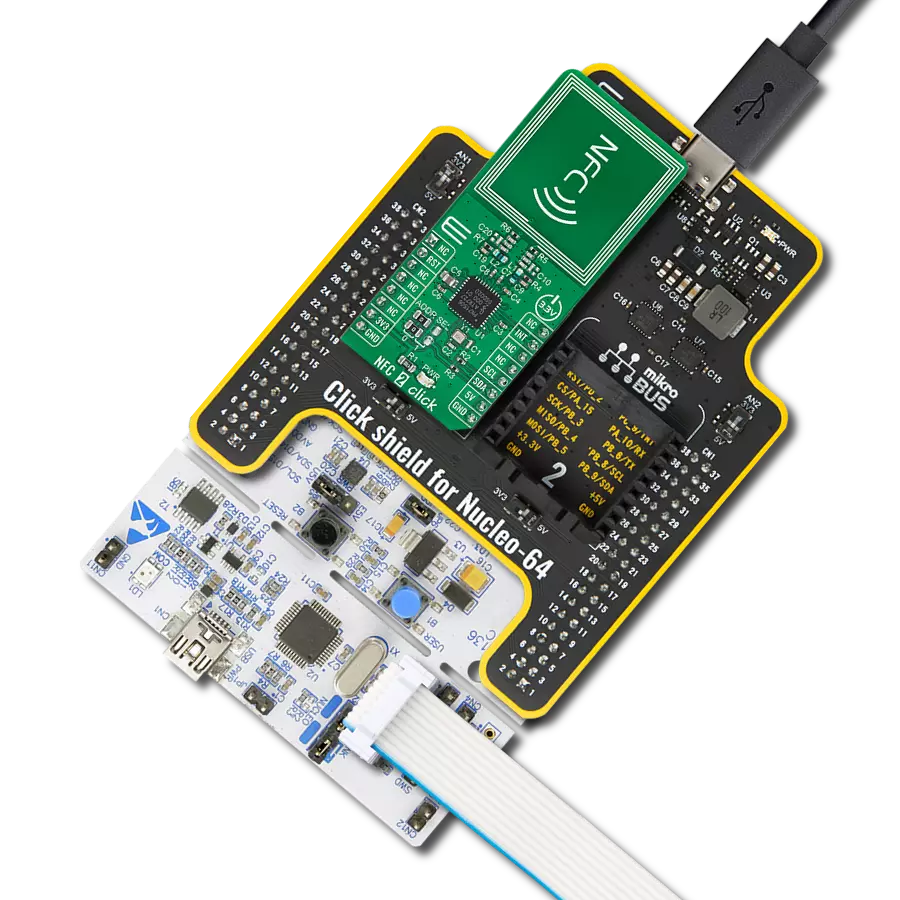Implement access control systems for secured entry with RFID card or tag authentication
A
A
Hardware Overview
How does it work?
RFID 2 Click is based on the ID-12LA-SA, an advanced low-cost RFID reader module designed for stand-alone or remote-controlled applications to identify and track tags attached to objects from ID Innovations. The ID-12LA-SA requires a supply voltage of up to 5V, supports normal mode (autonomous mode) of operation, incorporates internal antennas, and has read ranges of 12cm and 18cm. In normal mode, when a card is presented to the reader, the reader searches for the card in its EEROM memory (the EEROM area stores the password and the reader polling address as well as timing and other values), and if there is a match module sends feedback information through interrupt pin labeled as CP. This mode stops operating if the reader module detects a valid polled command. It is crucial to mention that it protects so that the reader
requires password authorization for system changes and the addition or removal of cards. In this way, the EEROM can be made safe and only restored with the password. The ID-12LA-SA module communicates with MCU using the UART interface that operates at 9600 bps by default configuration with commonly used UART RX and TX pins for data transfer. The ID-12LA-SA module sends the ID data to the TX UART pin for monitoring, and in Normal mode, the reader sends the ID data of every card it reads. As mentioned previously in the product description, additional functionality such as Reset and ‘Card Present’ interrupt is provided and routed at RST and INT pins of the mikroBUS™ socket labeled as RST and CP. The RFID 2 Click also features the CMT-8540S-SMT magnetic buzzer that sounds for approximately one second when a card is
detected, controlled by the NE555 precision timer capable of producing highly accurate time delays from Texas Instruments. Signal frequency determines the sound pitch, and the duty cycle determines the amplitude (sound volume), so the user can create a sound pattern of their choice. It also possesses the card read status LED indicator labeled READ, which indicates a successful detection of the ID card. This Click board™ can operate with either 3.3V or 5V logic voltage levels selected via the VCC SEL jumper. This way, both 3.3V and 5V capable MCUs can use the communication lines properly. Also, this Click board™ comes equipped with a library containing easy-to-use functions and an example code that can be used as a reference for further development.
Features overview
Development board
Nucleo-64 with STM32F410RB MCU offers a cost-effective and adaptable platform for developers to explore new ideas and prototype their designs. This board harnesses the versatility of the STM32 microcontroller, enabling users to select the optimal balance of performance and power consumption for their projects. It accommodates the STM32 microcontroller in the LQFP64 package and includes essential components such as a user LED, which doubles as an ARDUINO® signal, alongside user and reset push-buttons, and a 32.768kHz crystal oscillator for precise timing operations. Designed with expansion and flexibility in mind, the Nucleo-64 board features an ARDUINO® Uno V3 expansion connector and ST morpho extension pin
headers, granting complete access to the STM32's I/Os for comprehensive project integration. Power supply options are adaptable, supporting ST-LINK USB VBUS or external power sources, ensuring adaptability in various development environments. The board also has an on-board ST-LINK debugger/programmer with USB re-enumeration capability, simplifying the programming and debugging process. Moreover, the board is designed to simplify advanced development with its external SMPS for efficient Vcore logic supply, support for USB Device full speed or USB SNK/UFP full speed, and built-in cryptographic features, enhancing both the power efficiency and security of projects. Additional connectivity is
provided through dedicated connectors for external SMPS experimentation, a USB connector for the ST-LINK, and a MIPI® debug connector, expanding the possibilities for hardware interfacing and experimentation. Developers will find extensive support through comprehensive free software libraries and examples, courtesy of the STM32Cube MCU Package. This, combined with compatibility with a wide array of Integrated Development Environments (IDEs), including IAR Embedded Workbench®, MDK-ARM, and STM32CubeIDE, ensures a smooth and efficient development experience, allowing users to fully leverage the capabilities of the Nucleo-64 board in their projects.
Microcontroller Overview
MCU Card / MCU
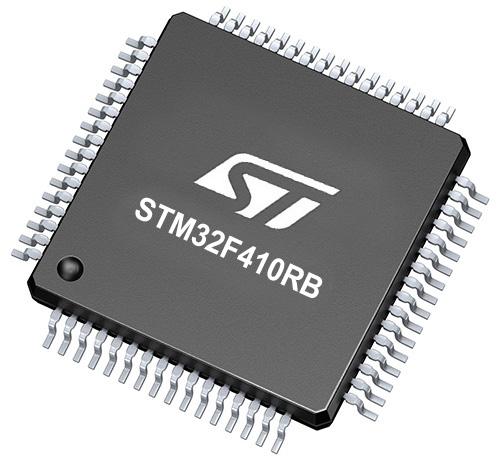
Architecture
ARM Cortex-M4
MCU Memory (KB)
128
Silicon Vendor
STMicroelectronics
Pin count
64
RAM (Bytes)
32768
You complete me!
Accessories
Click Shield for Nucleo-64 comes equipped with two proprietary mikroBUS™ sockets, allowing all the Click board™ devices to be interfaced with the STM32 Nucleo-64 board with no effort. This way, Mikroe allows its users to add any functionality from our ever-growing range of Click boards™, such as WiFi, GSM, GPS, Bluetooth, ZigBee, environmental sensors, LEDs, speech recognition, motor control, movement sensors, and many more. More than 1537 Click boards™, which can be stacked and integrated, are at your disposal. The STM32 Nucleo-64 boards are based on the microcontrollers in 64-pin packages, a 32-bit MCU with an ARM Cortex M4 processor operating at 84MHz, 512Kb Flash, and 96KB SRAM, divided into two regions where the top section represents the ST-Link/V2 debugger and programmer while the bottom section of the board is an actual development board. These boards are controlled and powered conveniently through a USB connection to program and efficiently debug the Nucleo-64 board out of the box, with an additional USB cable connected to the USB mini port on the board. Most of the STM32 microcontroller pins are brought to the IO pins on the left and right edge of the board, which are then connected to two existing mikroBUS™ sockets. This Click Shield also has several switches that perform functions such as selecting the logic levels of analog signals on mikroBUS™ sockets and selecting logic voltage levels of the mikroBUS™ sockets themselves. Besides, the user is offered the possibility of using any Click board™ with the help of existing bidirectional level-shifting voltage translators, regardless of whether the Click board™ operates at a 3.3V or 5V logic voltage level. Once you connect the STM32 Nucleo-64 board with our Click Shield for Nucleo-64, you can access hundreds of Click boards™, working with 3.3V or 5V logic voltage levels.
Used MCU Pins
mikroBUS™ mapper
Take a closer look
Click board™ Schematic

Step by step
Project assembly
Track your results in real time
Application Output
1. Application Output - In Debug mode, the 'Application Output' window enables real-time data monitoring, offering direct insight into execution results. Ensure proper data display by configuring the environment correctly using the provided tutorial.

2. UART Terminal - Use the UART Terminal to monitor data transmission via a USB to UART converter, allowing direct communication between the Click board™ and your development system. Configure the baud rate and other serial settings according to your project's requirements to ensure proper functionality. For step-by-step setup instructions, refer to the provided tutorial.

3. Plot Output - The Plot feature offers a powerful way to visualize real-time sensor data, enabling trend analysis, debugging, and comparison of multiple data points. To set it up correctly, follow the provided tutorial, which includes a step-by-step example of using the Plot feature to display Click board™ readings. To use the Plot feature in your code, use the function: plot(*insert_graph_name*, variable_name);. This is a general format, and it is up to the user to replace 'insert_graph_name' with the actual graph name and 'variable_name' with the parameter to be displayed.

Software Support
Library Description
This library contains API for RFID 2 Click driver.
Key functions:
rfid2_generic_write- This function writes a desired number of data bytes by using UART serial interface.rfid2_generic_read- This function reads a desired number of data bytes by using UART serial interface.rfid2_reset- This function resets the chip.
Open Source
Code example
The complete application code and a ready-to-use project are available through the NECTO Studio Package Manager for direct installation in the NECTO Studio. The application code can also be found on the MIKROE GitHub account.
/*!
* @file main.c
* @brief RFID 2 Click Example.
*
* # Description
* This example reads and processes data from RFID 2 Clicks.
*
* The demo application is composed of two sections :
*
* ## Application Init
* Initializes UART module and sets RST pin as OUTPUT and INT pin as INPUT, also,
* initializes Driver init and reset chip.
*
* ## Application Task
* Reads the ID card (HEX) and logs data on the USB UART.
*
* ## Additional Function
* - static void rfid2_clear_app_buf ( void ) - Function clears memory of app_buf.
* - static err_t rfid2_process ( void ) - The general process of collecting data the module sends.
*
* @author Jelena Milosavljevic
*
*/
#include "board.h"
#include "log.h"
#include "rfid2.h"
#define PROCESS_BUFFER_SIZE 200
static rfid2_t rfid2;
static log_t logger;
static char app_buf[ PROCESS_BUFFER_SIZE ] = { 0 };
static int32_t app_buf_len = 0;
static int32_t app_buf_cnt = 0;
/**
* @brief RFID 2 clearing application buffer.
* @details This function clears memory of application buffer and reset its length and counter.
* @note None.
*/
static void rfid2_clear_app_buf ( void );
/**
* @brief RFID 2 data reading function.
* @details This function reads data from device and concatenates data to application buffer.
*
* @return @li @c 0 - Read some data.
* @li @c -1 - Nothing is read.
* @li @c -2 - Application buffer overflow.
*
* See #err_t definition for detailed explanation.
* @note None.
*/
static err_t rfid2_process ( void );
void application_init ( void ) {
log_cfg_t log_cfg; /**< Logger config object. */
rfid2_cfg_t rfid2_cfg; /**< Click config object. */
/**
* Logger initialization.
* Default baud rate: 115200
* Default log level: LOG_LEVEL_DEBUG
* @note If USB_UART_RX and USB_UART_TX
* are defined as HAL_PIN_NC, you will
* need to define them manually for log to work.
* See @b LOG_MAP_USB_UART macro definition for detailed explanation.
*/
LOG_MAP_USB_UART( log_cfg );
log_init( &logger, &log_cfg );
log_info( &logger, " Application Init " );
// Click initialization.
rfid2_cfg_setup( &rfid2_cfg );
RFID2_MAP_MIKROBUS( rfid2_cfg, MIKROBUS_1 );
err_t init_flag = rfid2_init( &rfid2, &rfid2_cfg );
if ( UART_ERROR == init_flag ) {
log_error( &logger, " Application Init Error. " );
log_info( &logger, " Please, run program again... " );
for ( ; ; );
}
Delay_ms ( 100 );
rfid2_reset( &rfid2 );
Delay_ms ( 100 );
app_buf_len = 0;
app_buf_cnt = 0;
log_info( &logger, " Application Task " );
log_printf( &logger, "*** Please, put your ID card.***\r\n" );
log_printf( &logger, "*** ID card :\r\n" );
}
void application_task ( void ) {
app_buf_len = rfid2_generic_read( &rfid2, app_buf, PROCESS_BUFFER_SIZE );
if ( app_buf_len > 0 ) {
log_printf( &logger, "%s", app_buf );
memset( app_buf, 0, PROCESS_BUFFER_SIZE );
}
}
int main ( void )
{
/* Do not remove this line or clock might not be set correctly. */
#ifdef PREINIT_SUPPORTED
preinit();
#endif
application_init( );
for ( ; ; )
{
application_task( );
}
return 0;
}
static void rfid2_clear_app_buf ( void ) {
memset( app_buf, 0, app_buf_len );
app_buf_len = 0;
app_buf_cnt = 0;
}
static err_t rfid2_process ( void ) {
int32_t rx_size;
char rx_buff[ PROCESS_BUFFER_SIZE ] = { 0 };
rx_size = rfid2_generic_read( &rfid2, rx_buff, PROCESS_BUFFER_SIZE );
if ( rx_size > 0 ) {
int32_t buf_cnt = 0;
if ( app_buf_len + rx_size >= PROCESS_BUFFER_SIZE ) {
rfid2_clear_app_buf( );
return RFID2_ERROR;
}
else {
buf_cnt = app_buf_len;
app_buf_len += rx_size;
}
for ( int32_t rx_cnt = 0; rx_cnt < rx_size; rx_cnt++ ) {
if ( rx_buff[ rx_cnt ] != 0 ) {
app_buf[ ( buf_cnt + rx_cnt ) ] = rx_buff[ rx_cnt ];
}
else{
app_buf_len--;
buf_cnt--;
}
}
return RFID2_OK;
}
return RFID2_ERROR;
}
// ------------------------------------------------------------------------ END
Additional Support
Resources
Category:RFID/NFC

